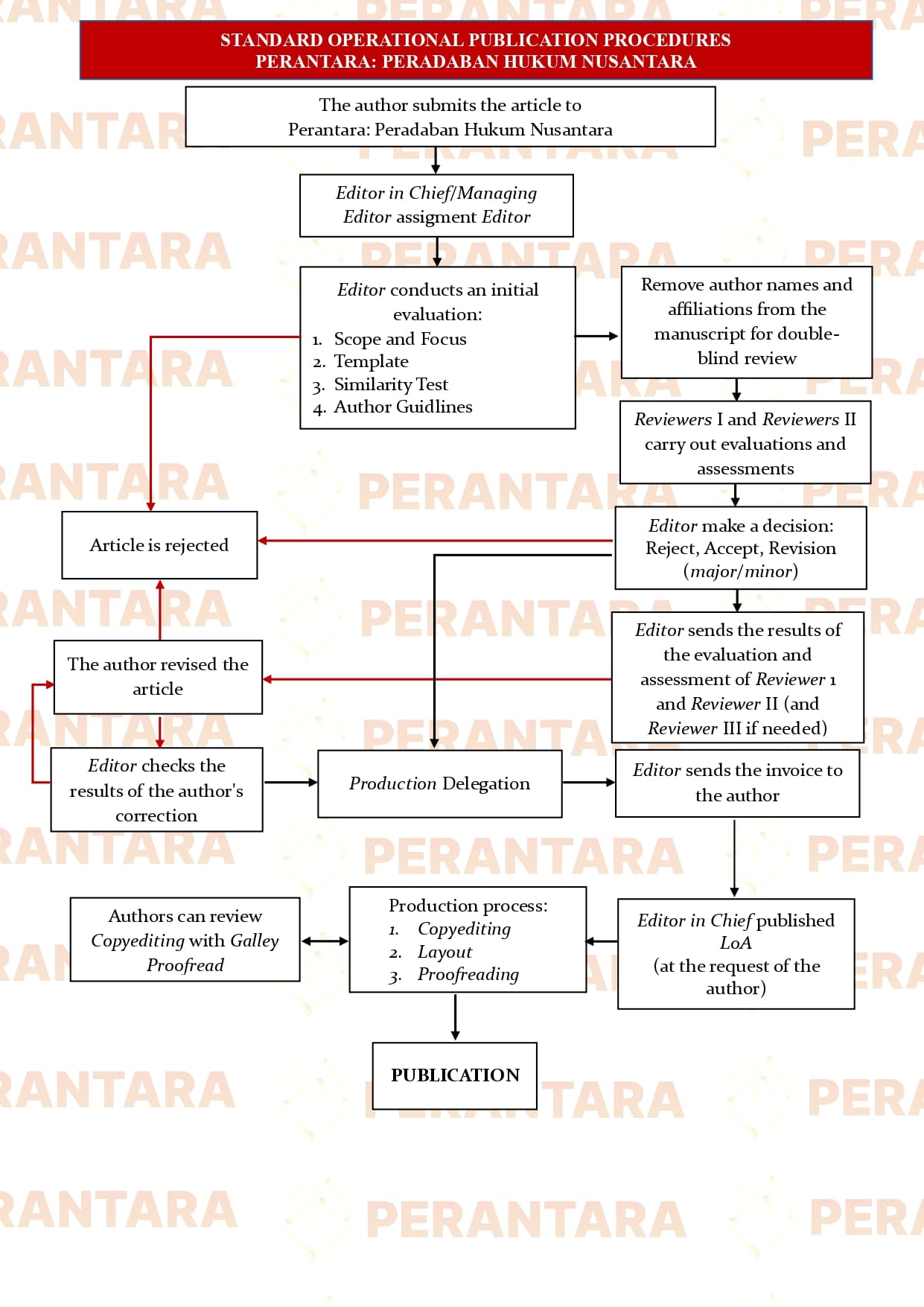ADDITIONAL MENU
Author Guidelines
General Requirement
1. Manuscripts submitted to Perantara: Peradaban Hukum Nusantara must be original works that have not been published elsewhere and do not contain any elements of plagiarism. A written declaration of originality must accompany the submission.
2. Articles must be written in English or Indonesian and contain between 15 to 25 pages, including tables, figures, and references.
3. The manuscript should be typed on A4-sized paper, using the following margins:
-
-
-
Top: 2.5 cm
-
Bottom: 2.5 cm
-
Left: 2.5 cm
-
Right: 2.5 cm
-
-
The manuscript must be formatted using:
-
Font: Cambria
-
Title: 16 pt, bold, centered, italicized, Sentence case
-
Heading Level 1 (e.g., INTRODUCTION): 14 pt, UPPERCASE, bold
-
Subheadings: 12 pt, Sentence case, bold
-
Main Text: 12 pt, justified, first-line indent 1 cm, 1.5 spacing
-
Footnotes: 10 pt, Cambria, single-spaced, with a 0.5 cm space between the number and the reference
-
Spacing between sections: one blank line
-
-
Citations must be written in footnote format, following the Chicago Manual of Style 17th Edition. Authors must use a reference manager (e.g., Zotero, RefWorks) for consistent citation and bibliography formatting.
-
Manuscript Structure
Title and Author Information
-
Title: 10–15 words, Cambria 16 pt, centered, italic, sentence case.
-
Author(s): Written in Verdana 12 pt, sentence case, without academic titles.
-
Affiliation(s): Written in Cambria 10 pt, centered. If the affiliation is from abroad, use italic.
-
Corresponding author’s name and institutional email must be included.
Specific Requirement
The structure of this journal adheres to the standard format of Scientific Research Reports (IMRaD), organized into 4 main sections: Introduction, Methods, Results and Discussion. Tittle Discussion for each formulated problem along with conclusions and recommendations (if any).
Abstract
Abstract consists of: Introduction, research objectives, methods (brief), discussion (findings), conclusions. The abstract is written in Indonesian and English using 10px Book Antiqua font. The abstract consists of 150-200 words and only 1 paragraph. The text written in Indonesian begins with an abstract (English abstract), and the text written in English begins with an abstrak (Indonesian abstract). The abstract is accompanied by 3-5 keywords representing the content of the manuscript. The abstract is written with proper writing conventions (no use of Google Translate).
Intruduction
The introduction consists of five paragraphs, each comprising 3-5 sentences. The first paragraph outlines the background of the studied problem and why it is worthy of investigation. This can be explained from the perspective of legal science layers or relevant philosophical, juridical, and/or sociological foundations associated with the research. The second paragraph presents the state of the art, which is a literature review of previous similar studies. This serves as the basis to justify the contributions and novelty of the research, including a gap analysis. This is followed by a novelty statement that summarizes the similarities and differences with previous research. The third paragraph contains the research's significance. In this section, the author explains why the study is crucial to be conducted, possibly connecting it to ius constituendum or due to its massive impact causing losses, disrupting public order, affecting national interests, and so forth. The fourth paragraph addresses the legal problems or issues that are the focus of the research. Ideally, these should be presented in the form of questions, and there can be more than one question that is interrelated. The legal problems or issues serve as a definition operationalized in the journal title. The fifth paragraph The research method is based on citations from books or scholarly journal articles, specifying the type of research (normative or empirical). This journal also accepts articles of socio-legal research type with the condition that it must be explicitly emphasized through an approach directly linked to the research relevance. The six paragraph outlines the research objectives in a straightforward and clear manner, avoiding the use of sentences like "Based on the background, the objectives of this research are... and so on”. The manuscript to be uploaded to the Intermediary Journal consists of 15 to 25 pages. The initial sentence of each paragraph in the manuscript is indented to the right by 5 spaces/1 cm, with 1.5 spacing, font size 12px, Book Antiqua. Legal issues are formulated in paragraph format, without using numbering or bullets. The issues are presented in the form of interrogative sentences.
Results And Discussion
Discussion of Legal Problems/Issue I
The discussion contains a description of the research findings in accordance with the formulated problems. Problem discussions are presented in chapters and/or sub-chapters, but should not include conceptual definitions, detailed points, descriptions of various types, explanations of different concepts, complete article and/or verse citations, and raw data. In the results and discussion chapter, there should be at least: (1) What/How elements in the form of a table/figure (choose one) accompanied by names at the top of the table.
In this section, a comprehensive explanation is provided along with the findings after the table. (2) The "why" element elucidates the relationship between the findings (research results) and the fundamental concepts and/or hypotheses. The discussion must be supported by clear and tangible facts. (3) The "what else" element outlines the conformity and/or contradictions with other research. Each element may consist of several paragraphs, but there should be apparent differences between each element.
Discussion of Legal Problems/Issue II
Each answer to the formulated legal problem/issue is discussed in separate sub-chapters, with 1.5 spacing, font size 12px, Book Antiqua, and the initial sentence of each paragraph indented by 5 spaces to the right. Direct quotations consisting of 5 lines or more are written with single spacing and separated from other paragraphs, with an indentation of 3 spaces to the right.
Conclusion
-
Provide concise answers to each legal issue.
-
Emphasize novelty and urgency.
-
No new discussion may be introduced.
-
Must be supported by research data and written in one paragraph (no bullets or numbering).
References (Bibliography)
-
Minimum of 30 references, at least 80% from primary sources (journals/proceedings).
-
Published within the last 10 years.
-
Use hanging indent (1 cm).
-
Alphabetized by the first author's last name.
-
Include only cited works in the manuscript.
















